Shoulder synovitis characterized by the development of degenerative-inflammatory processes, against the background of which the synovium suffers. Progressive pathological changes negatively affect the cartilage tissue, causing its irreversible damage.
The disease is accompanied by characteristic symptoms, requires a comprehensive diagnosis and properly selected treatment. Lack of therapy will lead to serious complications.
Record content:
- 1 What is synovitis?
- 2 Causes of fluid accumulation in the shoulder joint
- 3 Types of pathology
- 4 Symptomatic manifestations
- 5 Why is synovitis dangerous? Possible complications
- 6 Which doctor should I go to?
- 7 Diagnostics
-
8 Conservative treatment
- 8.1 Physiotherapy
- 8.2 Exercise therapy
- 9 Operative treatment
- 10 Folk remedies
- 11 Forecast
- 12 Video about synovitis
What is synovitis?
Synovitis is a disease in which the synovium of the joint becomes inflamed. A large amount of excess fluid accumulates. A pathological condition is a reaction of a joint to damage to its structures or the appearance of other disorders.
A large amount of excess fluid accumulates. A pathological condition is a reaction of a joint to damage to its structures or the appearance of other disorders.
Causes of fluid accumulation in the shoulder joint
There are numerous factors influencing the development of pathological processes in the area of the shoulder joint:
- damage and injury;
- infectious lesions of the body;
- purulent processes in the shoulder area;
- violation of material metabolism;
- allergic reaction;
- hormonal disorders;
- deforming changes in the musculoskeletal system;
- chronic diseases of the musculoskeletal system;
- sexually transmitted infections;
- endocrine diseases;
- degenerative and destructive pathologies of the joints.
Monotonous shoulder movements and strenuous physical activity can also provoke inflammation of the synovial membrane of the joint. The same applies to congenital or acquired diseases of the ligamentous apparatus, severe stress and anxiety.
Types of pathology
Synovitis of the shoulder joint (symptoms, treatment is determined by the doctor after a comprehensive examination) can be infectious and non-infectious. In the first case, pathological processes are provoked by pathogenic microorganisms that have entered the area of the shoulder joint through the blood or lymph.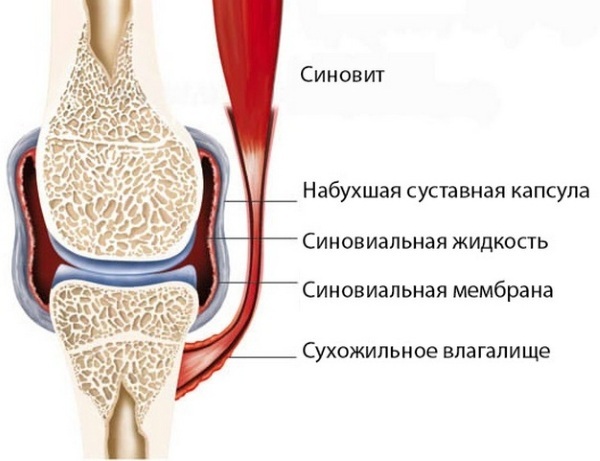
Non-infectious (aseptic) synovitis is classified as follows:
| Name | Description |
| Traumatic | The disease develops against the background of prolonged mechanical stress or as a result of a single injury. Traumatic synovitis of the shoulder joint is more often diagnosed in professional athletes or people with a diagnosis of hemophilia. |
| Allergic | A pathological condition occurs due to the constant influence of allergens on the human body. In rare cases, the disease develops after an infectious disease (tonsillitis, bronchitis, pneumonia). |
| Endocrine | Degenerative-dystrophic changes are a consequence of endocrine disorders in people with diabetes mellitus or metabolic disorders. |
| Neurogenic | The main cause of the disease is a strong emotional shock. The same applies to complications of neurological pathologies (neuritis, nerve entrapment, damage to it in scoliosis, fracture or tumor). |
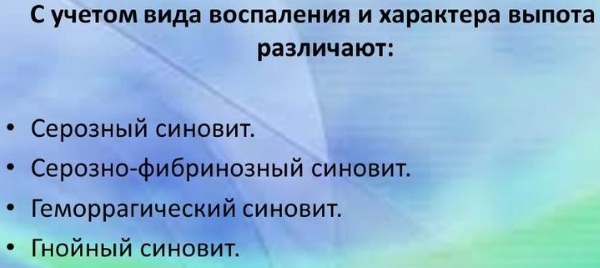
Synovitis of the shoulder joint develops in stages, at each stage occur certain changes and characteristic clinical symptoms appear:
| Name | Description |
| Stage I (primary) | In the area of the synovium, minor inflammation and reactive irritation develops. The same goes for edema, since a small amount of synovial fluid is secreted. |
| Stage II (serous) | Serous effusion is formed. The synovial membrane swells sharply, it acquires a velvety surface with large villi. |
| Stage III (purulent) | Pathological processes progress, dystrophic changes intensify, the synovial membrane becomes denser and saturated with purulent accumulations. Gradually, the inflammation spreads to the articular tissue and bones. |
A traumatologist or orthopedist will help to establish an accurate diagnosis, it is important to consult a specialist with the first clinical signs and undergo a comprehensive examination.
Symptomatic manifestations
Symptoms of shoulder joint synovitis will help the orthopedist or traumatologist determine the stage of the disease and prescribe the most informative examination. The specialist selects the treatment for the patient, taking into account the form of the pathology: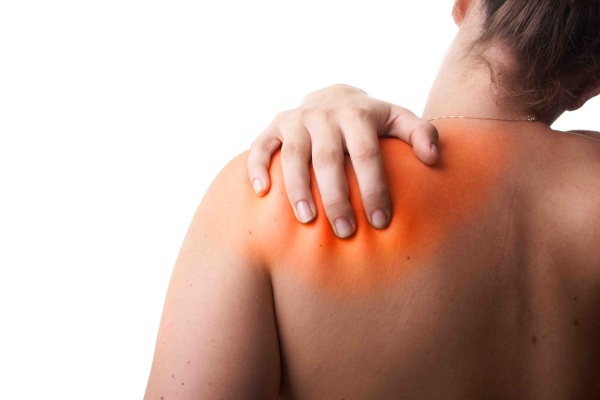
| Name | Symptoms |
| Acute form |
|
| Chronic form | The disease in some cases proceeds without pronounced symptoms, the following signs rarely appear:
Chronic synovitis of the shoulder joint occurs with periodic remissions and exacerbations. |
| Purulent form |
|
The purulent form of synovitis of the shoulder joint requires emergency medical care, since progressive pathological processes will lead to a deterioration in the patient's condition. The likelihood of serious complications is high.
Why is synovitis dangerous? Possible complications
In the absence of timely and correctly selected therapy, the synovitis of the shoulder joint progresses, the symptoms increase.
Degenerative-dystrophic processes provoke the appearance of complications:
| Name | Description |
| Panarthritis | A purulent form of arthritis, which is accompanied by an acute inflammatory process in the joint, ligamentous apparatus and periarticular tissues. |
| Phlegmon | The pathological condition is characterized by a purulent inflammatory process that affects soft tissues.
|
| Sepsis | Infectious agents enter the patient's blood, which spread throughout the body, worsening the patient's condition. |
The consequences of synovitis of the shoulder joint are also partial or complete immobility of the joint, chronic painful sensations.
Which doctor should I go to?
The diagnosis and treatment of synovitis of the shoulder joint is carried out by a traumatologist or orthopedist. Timely referral to a specialist and diagnosis of a pathological condition will allow you to choose the most effective treatment in order to prevent possible complications. You should not engage in therapy on your own, since you can aggravate your health condition.
Diagnostics
A comprehensive examination of a patient with suspected shoulder joint synovitis will confirm the previously established diagnosis and determine the degree of development of the disease. Based on the results obtained, the traumatologist will select the most effective therapy regimen for the patient.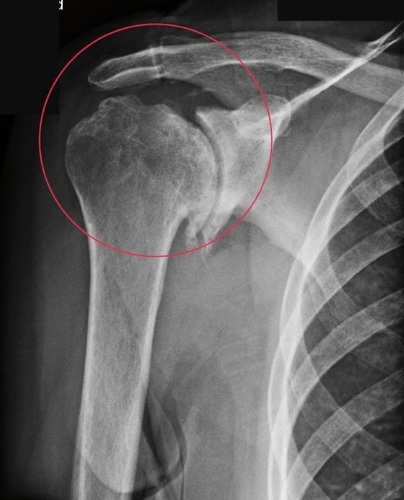
Synovitis of the shoulder joint (symptoms, treatment requires consultation with a doctor) help diagnose the following methods:
| Name | Description |
| X-ray | A diagnostic method that allows you to determine the volume of accumulated exudate and the area of \ u200b \ u200bthe lesion of the shoulder joint. |
| Ultrasound examination (ultrasound) | The specialist determines the thickness of the synovial membrane, the volume of exudate and pathological changes in the periarticular cavity. |
| Puncture | For the diagnosis, exudate is taken in the joint area. In the laboratory, inflammation or infection is detected. Establish the type of pathogen and its sensitivity to antibacterial agents. |
| Arthroscopy | A minimally invasive procedure, during which a specialist can visually examine the shoulder joint, identify pathological processes and the affected area. |
| Magnetic resonance imaging (MRI) | A diagnostic method that allows you to view the joint, cartilage and identify pathological changes. |
| Biopsy | For histological studies, a part of the synovium is taken. |
It is important to differentiate the disease, since many pathologies are accompanied by similar clinical signs (bursitis, arthritis).
In addition, the patient may need to consult other specialized doctors, taking into account the provoking factor of the disease (rheumatologist, arthrologist, allergist, surgeon, physiotherapist, massage therapist).
Conservative treatment
Medical therapy is selected by a traumatologist or orthopedist after a comprehensive examination, taking into account the results of diagnostics. It is important to strictly adhere to a specially selected regimen, since many drugs provoke side effects.
Synovitis of the shoulder joint involves the use of the following medications:
| Drug group | Name | Application |
| Non-steroidal anti-inflammatory drugs | Ketonal, Voltaren | Medicines reduce pain and inflammation. Capsules are taken orally after meals, without chewing and drinking plenty of water. The recommended dosage for adults is 1-2 tablets 2-3 times a day. |
| Antibiotics | Vancomycin, Amoxiclav | Drugs are prescribed for the infectious form of the disease. Medicines are given intravenously through an IV line. The adult dosage is 1 g every 12 hours. The drug is administered at 10 mg / min for 60 minutes. |
| Chondroprotectors | Alflutop, Teraflex | The preparations contribute to the nutrition and regeneration of cartilage tissue. Medicines are injected deeply intramuscularly or intra-articularly. Adults are prescribed 1-2 ml. Joint injections are given every 3-4 days. The course of treatment includes 5-6 injections. The drug is injected intramuscularly, 1 ml every day for 20 days. |
| Corticosteroids | Hydrocortisone, Dexamethasone | Medicines quickly eliminate the inflammatory process. The adult dosage is calculated based on the patient's condition. Patients are prescribed 0.5-9 mg per day. The course of treatment lasts 7 days. |
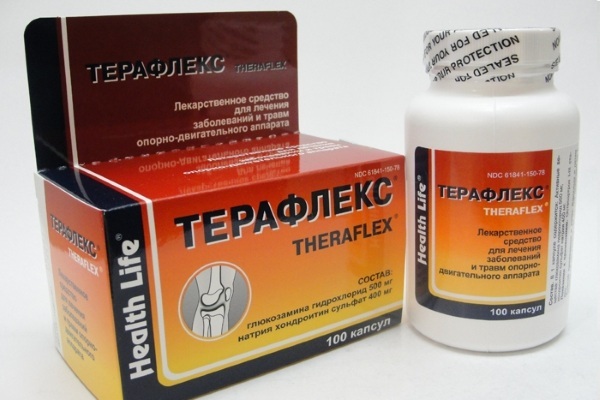
In addition, external agents (ointments, creams, gels) help to cope with painful sensations. Medicines are applied to the shoulder joint area 2-4 times a day and rubbed in with light massage movements.
Physiotherapy
Synovitis of the shoulder joint (symptoms, treatment is determined by a traumatologist or orthopedist) requires complex therapy and provides for patients to attend physiotherapy procedures, but strictly in the absence of painful sensations and after a recession period of exacerbation. Physiotherapy is selected by the doctor, taking into account the condition of the person and the individual characteristics of his body.
| Name | Description |
| Medicinal electrophoresis | With the help of constant currents, the active components of drugs enter the focus of inflammation and contribute to its reduction. Reduces not only its intensity, but also pain, swelling. |
| Magnetic therapy | During the treatment, a constant and alternating magnetic field is used. Impulses reduce pain syndrome, inflammation, improve blood circulation and the body's defense response. |
| Ultrasound treatment | Ultrasound waves improve blood circulation in the affected joint and surrounding tissues. The inflammatory process decreases, the regeneration of damaged structures is activated. |
Physiotherapy procedures for synovitis of the shoulder joint also provide for UHF therapy, the use of mud baths, reflexology is indicated.
Exercise therapy
In addition, for patients with synovitis of the shoulder joint, the specialist selects a complex of therapeutic exercises.
Exercise helps restore shoulder function and mobility:
- It is recommended to perform light rotations in a circle with the injured hand, first in one direction, then in the opposite direction. In this case, the body must be slightly tilted forward.
- In an upright position, align your back and place your feet shoulder-width apart. Slowly lift the sore arm up without bending at the elbow. Lead her behind her head. At this time, slowly raise the second hand from below behind the back. Exercises are performed slowly, alternating hands.
- While standing, grab your shoulders with your hands and raise them up. Make rotational movements in one and the other direction 2-3 times. Exercise improves metabolic processes and relieves pain.

Exercise should be done slowly, gradually increasing the load. If painful sensations appear, give up classes and consult your doctor.
Operative treatment
In emergency situations or in the absence of positive dynamics after drug therapy, the patient is shown surgical treatment of shoulder joint synovitis.
The operation is carried out by the following methods:
| Name | Description |
| Partial synovectomy | The synovium is partially removed. |
| Synovectomy | Total surgery, during which the doctor removes most of the synovial membrane of the shoulder joint. |
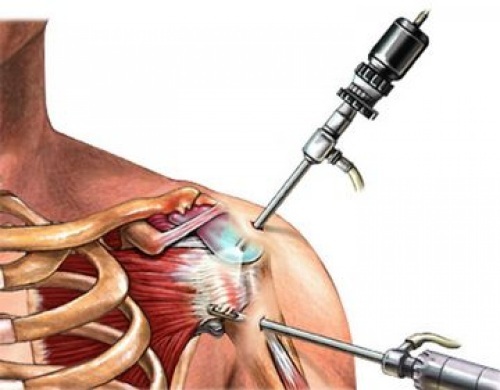
After surgical treatment, the patient will have a long rehabilitation period. The surgeon prescribes antibacterial drugs to prevent complications (Augmentin). Physiotherapy, therapeutic exercises and massage will also help you recover faster.
Folk remedies
Prescriptions of healers and healers are used in the complex therapy of shoulder joint synovitis. It is important to remember about the high likelihood of an allergic reaction and individual sensitivity. All folk remedies need to be discussed with your doctor, who will help you choose the most effective recipe.
Synovitis of the shoulder joint (symptoms, treatment requires complex diagnostics) allows the use of the following recipes:
| Name | Recipe | Application |
| Propolis | Mix 100 g of propolis and 150 ml of vegetable oil. Put the resulting mass in a water bath, warm until the propolis is completely dissolved. Cool the finished product and use it outside. | It is recommended to rub the resulting ointment into the affected shoulder joint with light massage movements. |
| Herbal collection | Mix in equal proportions calendula flowers, birch leaves, nettle and willow bark. Pour 1 tbsp. herbal collection with hot water (200 ml). Insist 1 hour and strain. | The ready-made broth is recommended to be consumed in 100 ml 3 times a day. The course of treatment lasts 10 days. |
| Laurel oil | Grind the bay leaves. Pour 3 tbsp. the resulting mass with vegetable oil (1 tbsp.). Insist covered for 2 weeks in a dark place. Shake the mixture periodically. | It is recommended to periodically rub the finished oil into the affected shoulder with light massage movements. |
| Comfrey tincture | Grind the root of the plant and pour 1 tbsp. vodka (1 l). The resulting mixture must be infused for 4 days. | The finished tincture should be taken orally, 1 tsp. 3 times a day before meals. |
| Healing ointment | Grind the leaves and stems of the golden mustache. Mix 2 tbsp. the resulting mass with baby cream (3 tablespoons). | It is recommended to rub the finished ointment into the sore joint in the morning and in the evening. |
As a compress on the shoulder, you can apply a cabbage leaf, having previously lubricated the affected area with natural honey. Then wrap with foil and cover with dense material. Compress reduces pain.
Forecast
The prognosis for synovitis of the shoulder joint depends on numerous circumstances, including the stage of development of the inflammatory process, how quickly the patient went to the hospital. Equally important is the correctly selected therapy and the person's observance of all the recommendations of the attending physician.
The early stage of synovitis is successfully treated with conservative methods for 1-2 weeks. The neglected forms of pathology require surgical intervention and rehabilitation.
Synovitis of the shoulder joint is not a dangerous disease, if you consult a traumatologist or orthopedist in a timely manner. Starting treatment at an early stage will prevent serious complications, as evidenced by the characteristic clinical symptoms.
Video about synovitis
About tenosynovitis:



